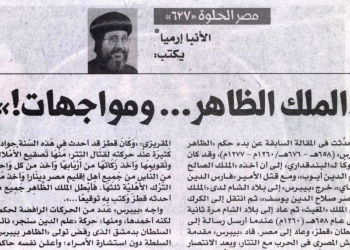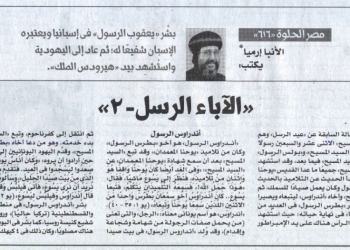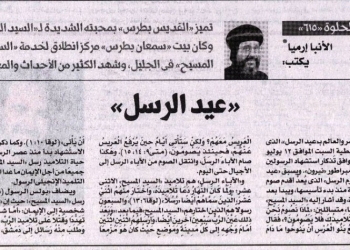In the previous article, we tackled the conquest of Alexandria as well as reconciling with the cities of Ikhna, Belheeb, and Tinnis which was overcome. Likewise, we spoke of Cyrus’s death, the return of Pope Benjamin to whom Amr wrote a letter of assurance, after which peace was restored to Alexandria. The congregation rejoiced for the Pope’s return, as he had been away for about thirteen years. The Pope restored those who strayed during Heraclius’ tenure and rebuilt the ruined churches and monasteries.
Amr bin al-‘As became proconsul of Egypt. According to Dr. Hassan Ibrahim Hassan, Amr wrote a letter to caliph Omar bin al-Khattab in which he described Egypt as follows:
“O Prince of believers, I am willing to tell you that Egypt has a dark soil (a fertile one). It is full of green plants. You need about sixty days to roam Egypt. Egypt is virgin land with a black mountain within, as well as reddish sands. The blessed Nile runs through it. It rises and drops in due course, just like the sun and the moon. There is a season for flooding and another for slumping. Egypt is full of milky flocks which feed on the abundance of greenery, as well as flies due to the abundance of water. When the Nile water rises, it overwhelms the land. So much so that you cannot move from one village to another except in small boats which look like tiny tree leaves flying in sunset breeze. Once the flood reaches its peak, it gradually drops. Mud rises, thus, allowing plantation to flourish. Subsequently, a lowly people would start plowing the land and throwing seeds into the soil. When the seeds sprout, they would ascribe it to their God, rather than their toil. When plants grow, begetting leaves and fruit, they are covered with dew. Egypt is white pearl, a black amber rod, a green emerald, a speckled agate, and a well written poem. Glory to God who fills this country with fruition and its people with happiness! Thus, its ruler is not to be betrayed by a coward, its taxes are not to be gathered unless the land gets green, and one-third of its height should be dedicated to bridges and canals. Should you approve of this, money will increase. May God guide us in our decisions.”
On the other hand, Abdul Aziz Jamal al-Din maintains that after conquering Alexandria on December 10, 641 A.D., Amr sent a letter to the caliph in which he described Alexandria as follows:
“God gave us a city that we conquered. It has four thousand palaces, four thousand baths, four hundred places of entertainment, twelve thousand green-grocers, and forty thousand Jews.” Jamal al-Din asserts that these numbers might be exaggerated or flawed due to copying issues. Yet, they indicate the greatness of the city which amazed conquerors. In fact, Alexandria had such marvelous water containers that fell into many levels. These containers were full of towering pillars. They would store water enough to meet people’s needs for a year. Alexandria was said to be, “a city that was built on a city. It has no counterpart on earth.” The Procyon was one of Alexandria’s most beautiful districts for it had Ptolemaics’ palaces, Alexander the Great tomb, the Bibliotheca Alexandrina, Ultrapolis Temple, and Maria-Ruthia Church.
As for St. Mark’s Church which contained his blessed body, Arculfus writes, that it was located in the north. There were two marble obelisks in the middle of the city. Likewise, there were two great monuments before Cicero Church. The city also contained a temple of Serapis, Diocletian’s Pillar, and the Lighthouse which was built during the Ptolemaic era to guide ships. It is located in the north east of Pharos Island which is connected to Alexandria through Heptastadium. Also, the city had the Churches of St. Sophia and St. Fustus.
After becoming proconsul, Amr ordered that a gulf be dug between the Nile and the Red Sea. It was called the Prince of Believer’s Gulf. The year 644 was called the year of Epistaxis to indicate how numerous the people who suffered from nose-bleeding were. Also, Muslims were split into Umayyads and Hashemites. During the tenure of Uthman bin Affan, he appointed Abdullah bin Sa’d bin Abu Sarh proconsul of Egypt.
The Revolt of Alexandria
Jamal al-Din asserts that Abdullah bin Sa’d was the worst of Egypt’s proconsuls. So much so that al-Tabari wrote about him the following: “None of Uthman’s appointees was as bad as Abdullah, the proconsul of Egypt!” The revolt of Alexandria ensued from the oppression which people were subject to. Such heavy taxes were imposed upon them that they sought the help of the Roman Emperor who sent a fleet led by Manuel to conquer Alexandria.
The Roman Emperor made a pre-emptive attack. He hid his preparation of a fleet which consisted of three hundred warships with which he entered the harbor. On the other hand, the Arabs were fewer in number than the Romans. Romans prevailed at first and were able to retrieve the city. This occurred in 645 A.D.
Afterward, the Roman troops headed toward Lower Egypt. When the news of the revolt reached the Arabs, Amr returned in order to lead the troops and retrieve the lost cities. Amr was an intelligent commander whom nobody could compete with. Reaching Babylon fortress, he waited for the Romans to come over to him, for he had set a plan to allow the Romans to move first that they might face rebellions and resistance while passing by cities and fortresses. He knew they would march from Alexandria to Babylon, which will make them lose men and supplies, thus making it easy for Arabs to prevail.
Upon reaching Nikiu, a fierce battle broke out between the two armies. The Roman general was killed and the army defeated. So, the Roman troops fled to Alexandria. Amr followed them and tried to invade Alexandria. Yet, he failed due to its fences. A door keeper called bin Bassama offered to open one of the gates to the Arab army in return of a promise of safety from Amr, which the latter accepted. Thus, the Arab armies entered Alexandria, expelled all the Romans who were there after killing a large number, of whom was Manuel. Alexandria was conquered in 645 A.D.
Pope Benjamin I spent the rest of his life building and restoring. He had ordained a priest called Agathon to be his deputy and in charge of the church’s affairs. That priest came from Alexandria. He had witnessed all the persecutions which Copts went through. So, he kept strengthening and helping them until the Pope’s return. The Pope suffered from a leg disease for two years. He departed in 659 A.D. This was a story. Stories never end in Beautiful Egypt.
General Bishop
Head of the Coptic Orthodox Cultural Center


 العربية
العربية











